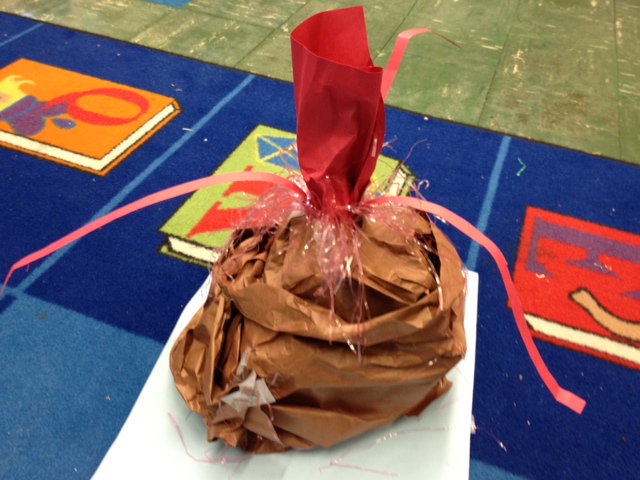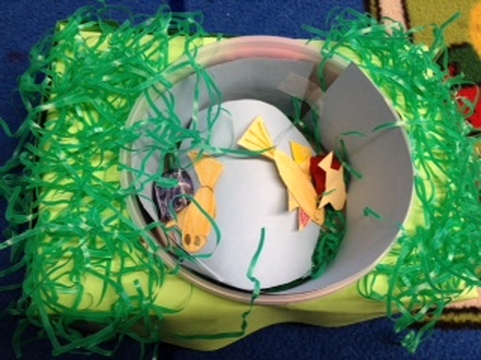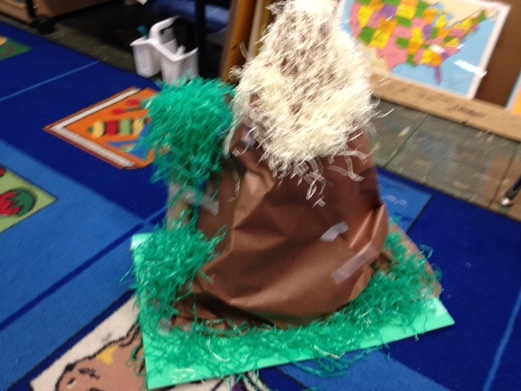
Description: This lesson serves as a culminating activity to a ten day unit of Landforms and Natural Resources. Landforms are around us everywhere and quietly affect our everyday lives. Knowledge of natural resources provides both awareness and protection of our precious planet. This lesson will also cover a family involvement component in which parents will be asked to provide their child with recyclable items to use in the activity.
Rationale: Throughout the Landforms and Natural Resources unit, the students have learned about types of landforms in addition to various resources and how we reuse and sometimes abuse these resources. Landforms and natural resources are crucial topics for second graders to be introduced to as they will always be a part of the greater world beyond the classroom. This culminating activity marries the two concepts: Landforms and Natural Resources in a creative and memorable way. Students will have to use their creativity in addition to what they have learned throughout the unit.
Prior Knowledge: As this lesson is a culminating lesson, students should apply what they have learned in the entirety of the unit, the nine days prior. To complete this activity, they must first understand natural resources and how we can conserve natural resources by reusing and recycling materials. They must know which materials qualify as recyclable materials that they can use in this activity. Students may show their misconceptions by bringing in items that are not recyclable. In this case we will sort through the recyclable and non-recyclable items as a class. To complete the activity in class, students must know some of the distinctions and characteristics of the landform they have been given as they will be asked to model these landforms out of the materials they have collected. We believe getting to construct their own landforms; something that they cannot necessarily do in the real world, will certainly capture their imaginations.
New Jersey Core Curriculum Content Standards
6.6.2.B.1. Places and Regions
Describe the physical features of places and regions as on a simple scale
6.6.2.E.1 Environment and Society
Describe the role of resources such as air, land, water, and plants in everyday life.
6.6.2.E.3 Environment and Society
Act on a small scale, personalized environmental issues as littering and recycling and explain how such actions are important
Objectives
Students will be able to construct a landform displaying its defining characteristics
Assessments
Students build their landform with the defining characteristics we have discussed
Hook: Hold up a funnel (cone shape) made out of newspaper for the students to see. Ask students, “What does this look like to you?” Have about 5 students share their answers and then say, “Hmm, This looks to me like a mountain peak. See the pointed shape when I turn it this way?” Today we are going to use the materials you have all brought in and our wonderful imaginations to make our own landforms.
Activities: Students will be called back to the carpet to view the “hook”. We will do our “hook” as explained above. We will review our characteristics of landforms as it has now been a few days since the students have worked with them directly. We will review by using the flashcards we have made as a class in Day One’s lesson. Next we will explain to children the task: Working in groups of three, you will use the recyclables we have brought in to build the landform we assign you. We will spend a few minutes on simply the management of this activity. We will read off the groups and give each group a piece of paper with their assigned landform. One person will be in charge of getting tools such as scissors, glue, tape and colored paper. We will designate this person and the place in the room where they will work. After we have entertained questions and fully explained, we will then dismiss groups from the carpet. We will help students with the construction and cue them with Mrs. Masterson’s bell when we want them to finish up building. We will cue them 5 minutes after that to have them clean up their workspace. We will then pass out a worksheet with three questions on it: 1.What is the name of the landform you made? List some characteristics, 2. What items did you use to make it? 3. Why is it important to reduce, reuse, and recycle? We will have groups present the landform they made by answering the questions provided on the worksheet. We will display these landforms in the back of the room to “celebrate” them post-lesson.
Materials: Recyclable materials such as milk jugs, newspaper, soup cans, cereal boxes etc., glue, tape, colored paper, scissors, the landform cards from Day One, newspaper funnel for hook, worksheets
Questions:
What does a (landform) look like?
Can you list some of the characteristics of this landform?
Can you recycle (item)?
Can you distinguish between a lake and an ocean?
What are the differences between a hill and a mountain?
Can you name a famous mountain range?
Can you name a landform surrounded by water?
What are some ‘recyclables’ that are natural resources?
What is the problem with not conserving and reusing materials?
Can you design something from these recyclables that looks like a landform?
Closure: To close this lesson as well as the unit, we will have each group present the landform they have constructed and talk about the materials they used to construct it. Most importantly we will have students explain the importance of recycling and reusing to help the planet. This will be a final review of characteristics of landforms as well as using recyclable materials to conserve natural resources. In addition, Mrs. Masterson has informed us that we will use their projects as our exhibit in the science fair!
Individualization: This activity is very individualized in that it allows every student to express their creativity in their own way. However, if a student is feeling too shy to speak in front of the class when presenting, we will allow that student to be the recorder for the group. That student will record the answers to the three questions that the other group members will then share with the class. If students are having trouble we will give them the card that displays the characteristics of the landform or perhaps give them an idea or two to get them started. Early finishers will help clean up materials and can do“recall” writing about the steps to how they constructed their landform.
Follow-up Activities: Although this activity is the culminating lesson of the unit, students’ knowledge of landforms and natural resources can be revisited when it is Earth Day on April 22!
Name__________________________
1. What is the landform? What are some of its characteristics?
2. What did you use to make your landform? (Did you recycle or reuse anything?)
3. Why do you think conserving, reusing and recycling are important to do?
Rationale: Throughout the Landforms and Natural Resources unit, the students have learned about types of landforms in addition to various resources and how we reuse and sometimes abuse these resources. Landforms and natural resources are crucial topics for second graders to be introduced to as they will always be a part of the greater world beyond the classroom. This culminating activity marries the two concepts: Landforms and Natural Resources in a creative and memorable way. Students will have to use their creativity in addition to what they have learned throughout the unit.
Prior Knowledge: As this lesson is a culminating lesson, students should apply what they have learned in the entirety of the unit, the nine days prior. To complete this activity, they must first understand natural resources and how we can conserve natural resources by reusing and recycling materials. They must know which materials qualify as recyclable materials that they can use in this activity. Students may show their misconceptions by bringing in items that are not recyclable. In this case we will sort through the recyclable and non-recyclable items as a class. To complete the activity in class, students must know some of the distinctions and characteristics of the landform they have been given as they will be asked to model these landforms out of the materials they have collected. We believe getting to construct their own landforms; something that they cannot necessarily do in the real world, will certainly capture their imaginations.
New Jersey Core Curriculum Content Standards
6.6.2.B.1. Places and Regions
Describe the physical features of places and regions as on a simple scale
6.6.2.E.1 Environment and Society
Describe the role of resources such as air, land, water, and plants in everyday life.
6.6.2.E.3 Environment and Society
Act on a small scale, personalized environmental issues as littering and recycling and explain how such actions are important
Objectives
Students will be able to construct a landform displaying its defining characteristics
Assessments
Students build their landform with the defining characteristics we have discussed
Hook: Hold up a funnel (cone shape) made out of newspaper for the students to see. Ask students, “What does this look like to you?” Have about 5 students share their answers and then say, “Hmm, This looks to me like a mountain peak. See the pointed shape when I turn it this way?” Today we are going to use the materials you have all brought in and our wonderful imaginations to make our own landforms.
Activities: Students will be called back to the carpet to view the “hook”. We will do our “hook” as explained above. We will review our characteristics of landforms as it has now been a few days since the students have worked with them directly. We will review by using the flashcards we have made as a class in Day One’s lesson. Next we will explain to children the task: Working in groups of three, you will use the recyclables we have brought in to build the landform we assign you. We will spend a few minutes on simply the management of this activity. We will read off the groups and give each group a piece of paper with their assigned landform. One person will be in charge of getting tools such as scissors, glue, tape and colored paper. We will designate this person and the place in the room where they will work. After we have entertained questions and fully explained, we will then dismiss groups from the carpet. We will help students with the construction and cue them with Mrs. Masterson’s bell when we want them to finish up building. We will cue them 5 minutes after that to have them clean up their workspace. We will then pass out a worksheet with three questions on it: 1.What is the name of the landform you made? List some characteristics, 2. What items did you use to make it? 3. Why is it important to reduce, reuse, and recycle? We will have groups present the landform they made by answering the questions provided on the worksheet. We will display these landforms in the back of the room to “celebrate” them post-lesson.
Materials: Recyclable materials such as milk jugs, newspaper, soup cans, cereal boxes etc., glue, tape, colored paper, scissors, the landform cards from Day One, newspaper funnel for hook, worksheets
Questions:
What does a (landform) look like?
Can you list some of the characteristics of this landform?
Can you recycle (item)?
Can you distinguish between a lake and an ocean?
What are the differences between a hill and a mountain?
Can you name a famous mountain range?
Can you name a landform surrounded by water?
What are some ‘recyclables’ that are natural resources?
What is the problem with not conserving and reusing materials?
Can you design something from these recyclables that looks like a landform?
Closure: To close this lesson as well as the unit, we will have each group present the landform they have constructed and talk about the materials they used to construct it. Most importantly we will have students explain the importance of recycling and reusing to help the planet. This will be a final review of characteristics of landforms as well as using recyclable materials to conserve natural resources. In addition, Mrs. Masterson has informed us that we will use their projects as our exhibit in the science fair!
Individualization: This activity is very individualized in that it allows every student to express their creativity in their own way. However, if a student is feeling too shy to speak in front of the class when presenting, we will allow that student to be the recorder for the group. That student will record the answers to the three questions that the other group members will then share with the class. If students are having trouble we will give them the card that displays the characteristics of the landform or perhaps give them an idea or two to get them started. Early finishers will help clean up materials and can do“recall” writing about the steps to how they constructed their landform.
Follow-up Activities: Although this activity is the culminating lesson of the unit, students’ knowledge of landforms and natural resources can be revisited when it is Earth Day on April 22!
Name__________________________
1. What is the landform? What are some of its characteristics?
2. What did you use to make your landform? (Did you recycle or reuse anything?)
3. Why do you think conserving, reusing and recycling are important to do?



